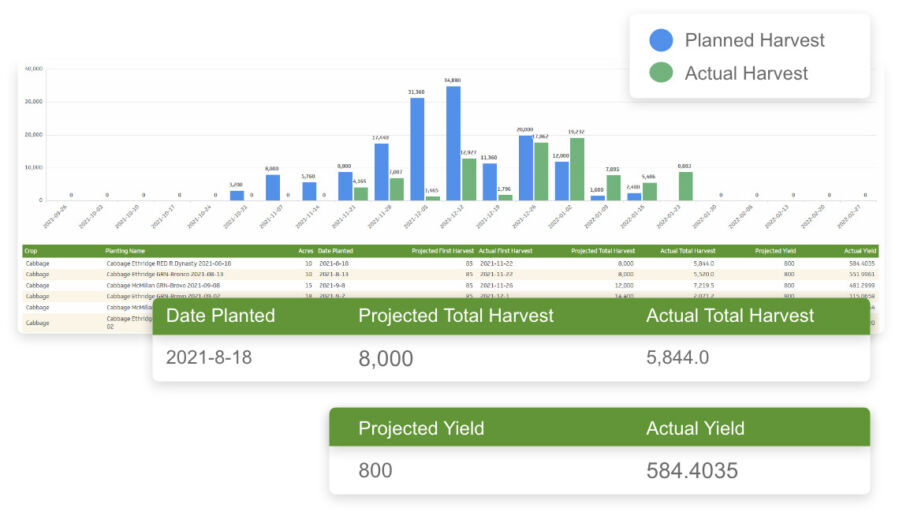
Technological advancements continue to reshape numerous industries, and the agricultural sector is no exception. Farmers and growers have embraced technology to optimize their practices, increase efficiency, and ultimately maximize their yields. One area where technology has revolutionized traditional methods is harvest forecasting. Accurate predictions of harvest yields play a vital role in planning, resource allocation, and market strategies. Technology can be harnessed to enhance harvest forecasting, enabling you to make informed decisions and achieve greater productivity in your fields. However, many struggle with harvest forecasting for a variety of reasons.
Some of the common challenges you may face when trying to forecast your harvest include:
Variability in Weather
Weather plays a critical role in crop growth and yield, and you may struggle to accurately predict weather conditions throughout the growing season. Variability in weather patterns, such as droughts, floods, or extreme temperatures, can significantly impact crop growth and yield, making it challenging to accurately forecast harvest.
Pest and Disease Outbreaks
Pests and diseases can cause significant damage to crops, leading to reduced yields and lower quality. Outbreaks can be difficult to predict and control, and you may struggle to accurately forecast their harvest when dealing with these issues.
Soil Variability
Soil variability can have a significant impact on crop growth and yield, and you may struggle to accurately predict how soil conditions will impact your harvest. Soil variability can be caused by factors such as soil texture, nutrient content, and pH levels, among others.
Crop Management Practices
You may struggle to accurately forecast your harvest if you are not using best practices for crop management. Poor soil health, insufficient fertilization, and inadequate pest management practices can all impact crop growth and yield, making it difficult to accurately forecast harvest.
Limited Access to Data and Technology
Harvest forecasting requires access to data and technology, which may be limited in some farming communities. If you lack access to the latest technologies and data analysis tools, you may struggle to accurately forecast your harvest.
Overall, you may face many challenges when trying to accurately forecast your harvest, but by using best practices for crop management, adopting new technologies, and analyzing data, you can improve your accuracy and make more informed decisions about crop management practices.
Traditional Harvest Forecasting
Forecasting your farm harvest can help you plan your marketing, sales, and distribution strategies, and make informed decisions about your crop management practices. Traditionally, farmers use the following methods to conduct harvest forecasting:
Estimate Yields
The first step in forecasting your farm harvest is to estimate how much you expect to harvest. You can estimate yields by using historical data, soil and weather data, and current crop growth stages. There are also crop-specific tools available that can help estimate yields.
Monitor Crop Growth
Monitoring your crop growth throughout the growing season can help you identify potential problems early and adjust your management practices to optimize yields. Keep track of key growth indicators like plant height, flowering, and fruit set to help you identify when to expect the harvest.
Use Technology
Technology can be a valuable tool in forecasting your farm harvest. Tools like remote sensing and satellite imagery can provide real-time data on crop growth and yield potential. There are also software programs available that can help you analyze data and generate forecasts.
Factor in External Factors
External factors like weather, pests, and diseases can impact your harvest forecast. Keep an eye on weather forecasts and pest and disease alerts to help you anticipate potential problems and adjust your forecast accordingly.
Adjust Your Forecast
As the growing season progresses, you may need to adjust your harvest forecast based on changes in weather, crop health, and other factors. Continuously monitor your crop growth and adjust your forecast as needed.
By following these steps, you can generate an accurate harvest forecast that can help you make informed decisions about your crop management practices and plan your marketing and distribution strategies.
How to Use Technology for Better Harvest Forecasting
Technology can be a valuable tool for better harvest forecasting. Here are some ways you can use technology to improve your harvest forecasting:
Remote Sensing and Imagery
Remote sensing and imagery technologies, such as satellite imagery, can provide you with real-time data on crop growth and yield potential. This data can be used to identify areas of high and low yield potential, allowing you to adjust your harvest forecast accordingly.
Crop Monitoring Devices
Crop monitoring devices, such as soil moisture sensors and weather stations, can provide you with real-time data on soil moisture, temperature, and other important environmental factors. This data can help you anticipate changes in weather patterns and identify potential crop stressors that may impact your harvest.
Yield Mapping Software
Yield mapping software can help you analyze data on crop yield, soil quality, and other important factors. This software can generate yield maps that show areas of high and low yield potential, allowing you to adjust your harvest forecast accordingly.
Farm Management Software
Farm management software can help you collect and analyze data on crop growth, weather, and other important factors. This software can generate reports and forecasts that provide you with a better understanding of your crop yield potential.
Artificial Intelligence
Artificial intelligence (AI) technologies, such as machine learning and predictive modeling, can help you analyze large amounts of data to generate more accurate harvest forecasts. AI can also help you identify patterns and trends that may impact your harvest, allowing you to adjust your management practices accordingly.
By leveraging these technologies, you can make more informed decisions about your crop management practices and generate more accurate harvest forecasts. Additionally, these technologies can help you optimize your use of resources, reduce waste, and improve your overall farm productivity and profitability.
With AgSquared, farm business owners can perform remote sensing, crop planning, harvest forecasting, and more right in the palm of their hands. Contact AgSquared to learn more about how farm management software can elevate your profits, productivity, and transparency.

